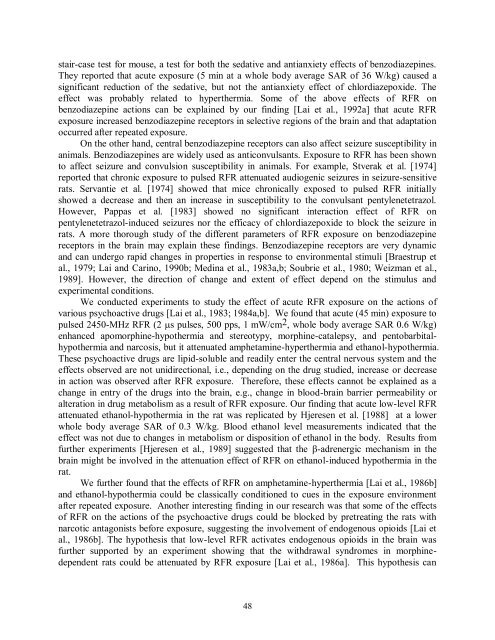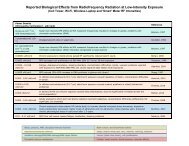Evidence for Effects on Neurology and Behavior - BioInitiative Report
Evidence for Effects on Neurology and Behavior - BioInitiative Report
Evidence for Effects on Neurology and Behavior - BioInitiative Report
Create successful ePaper yourself
Turn your PDF publications into a flip-book with our unique Google optimized e-Paper software.
stair-case test <str<strong>on</strong>g>for</str<strong>on</strong>g> mouse, a test <str<strong>on</strong>g>for</str<strong>on</strong>g> both the sedative <strong>and</strong> antianxiety effects of benzodiazepines.<br />
They reported that acute exposure (5 min at a whole body average SAR of 36 W/kg) caused a<br />
significant reducti<strong>on</strong> of the sedative, but not the antianxiety effect of chlordiazepoxide. The<br />
effect was probably related to hyperthermia. Some of the above effects of RFR <strong>on</strong><br />
benzodiazepine acti<strong>on</strong>s can be explained by our finding [Lai et al., 1992a] that acute RFR<br />
exposure increased benzodiazepine receptors in selective regi<strong>on</strong>s of the brain <strong>and</strong> that adaptati<strong>on</strong><br />
occurred after repeated exposure.<br />
On the other h<strong>and</strong>, central benzodiazepine receptors can also affect seizure susceptibility in<br />
animals. Benzodiazepines are widely used as antic<strong>on</strong>vulsants. Exposure to RFR has been shown<br />
to affect seizure <strong>and</strong> c<strong>on</strong>vulsi<strong>on</strong> susceptibility in animals. For example, Stverak et al. [1974]<br />
reported that chr<strong>on</strong>ic exposure to pulsed RFR attenuated audiogenic seizures in seizure-sensitive<br />
rats. Servantie et al. [1974] showed that mice chr<strong>on</strong>ically exposed to pulsed RFR initially<br />
showed a decrease <strong>and</strong> then an increase in susceptibility to the c<strong>on</strong>vulsant pentylenetetrazol.<br />
However, Pappas et al. [1983] showed no significant interacti<strong>on</strong> effect of RFR <strong>on</strong><br />
pentylenetetrazol-induced seizures nor the efficacy of chlordiazepoxide to block the seizure in<br />
rats. A more thorough study of the different parameters of RFR exposure <strong>on</strong> benzodiazepine<br />
receptors in the brain may explain these findings. Benzodiazepine receptors are very dynamic<br />
<strong>and</strong> can undergo rapid changes in properties in resp<strong>on</strong>se to envir<strong>on</strong>mental stimuli [Braestrup et<br />
al., 1979; Lai <strong>and</strong> Carino, 1990b; Medina et al., 1983a,b; Soubrie et al., 1980; Weizman et al.,<br />
1989]. However, the directi<strong>on</strong> of change <strong>and</strong> extent of effect depend <strong>on</strong> the stimulus <strong>and</strong><br />
experimental c<strong>on</strong>diti<strong>on</strong>s.<br />
We c<strong>on</strong>ducted experiments to study the effect of acute RFR exposure <strong>on</strong> the acti<strong>on</strong>s of<br />
various psychoactive drugs [Lai et al., 1983; 1984a,b]. We found that acute (45 min) exposure to<br />
pulsed 2450-MHz RFR (2 s pulses, 500 pps, 1 mW/cm 2 , whole body average SAR 0.6 W/kg)<br />
enhanced apomorphine-hypothermia <strong>and</strong> stereotypy, morphine-catalepsy, <strong>and</strong> pentobarbitalhypothermia<br />
<strong>and</strong> narcosis, but it attenuated amphetamine-hyperthermia <strong>and</strong> ethanol-hypothermia.<br />
These psychoactive drugs are lipid-soluble <strong>and</strong> readily enter the central nervous system <strong>and</strong> the<br />
effects observed are not unidirecti<strong>on</strong>al, i.e., depending <strong>on</strong> the drug studied, increase or decrease<br />
in acti<strong>on</strong> was observed after RFR exposure. There<str<strong>on</strong>g>for</str<strong>on</strong>g>e, these effects cannot be explained as a<br />
change in entry of the drugs into the brain, e.g., change in blood-brain barrier permeability or<br />
alterati<strong>on</strong> in drug metabolism as a result of RFR exposure. Our finding that acute low-level RFR<br />
attenuated ethanol-hypothermia in the rat was replicated by Hjeresen et al. [1988] at a lower<br />
whole body average SAR of 0.3 W/kg. Blood ethanol level measurements indicated that the<br />
effect was not due to changes in metabolism or dispositi<strong>on</strong> of ethanol in the body. Results from<br />
further experiments [Hjeresen et al., 1989] suggested that the -adrenergic mechanism in the<br />
brain might be involved in the attenuati<strong>on</strong> effect of RFR <strong>on</strong> ethanol-induced hypothermia in the<br />
rat.<br />
We further found that the effects of RFR <strong>on</strong> amphetamine-hyperthermia [Lai et al., 1986b]<br />
<strong>and</strong> ethanol-hypothermia could be classically c<strong>on</strong>diti<strong>on</strong>ed to cues in the exposure envir<strong>on</strong>ment<br />
after repeated exposure. Another interesting finding in our research was that some of the effects<br />
of RFR <strong>on</strong> the acti<strong>on</strong>s of the psychoactive drugs could be blocked by pretreating the rats with<br />
narcotic antag<strong>on</strong>ists be<str<strong>on</strong>g>for</str<strong>on</strong>g>e exposure, suggesting the involvement of endogenous opioids [Lai et<br />
al., 1986b]. The hypothesis that low-level RFR activates endogenous opioids in the brain was<br />
further supported by an experiment showing that the withdrawal syndromes in morphinedependent<br />
rats could be attenuated by RFR exposure [Lai et al., 1986a]. This hypothesis can<br />
48



